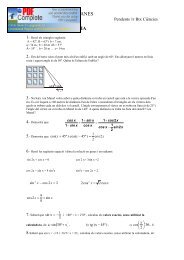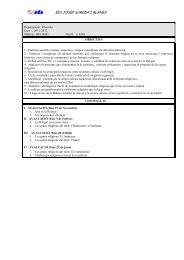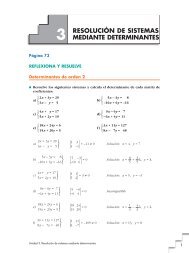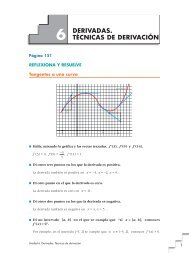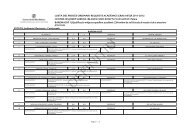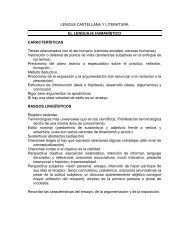APLICACIONES DE LAS DERIVADAS
APLICACIONES DE LAS DERIVADAS
APLICACIONES DE LAS DERIVADAS
You also want an ePaper? Increase the reach of your titles
YUMPU automatically turns print PDFs into web optimized ePapers that Google loves.
UNIDAD<br />
7<br />
s24<br />
Calcula p y q de modo que la curva y = x 2 + px + q contenga al punto<br />
(–2, 1) y presente un mínimo en x = –3.<br />
y = x 2 + px + q 8 f'(x) = 2x + p<br />
f(–2) = 4 – 2p + q = 1<br />
f'(–3) = 2(–3) + p = 0 8 p = 6 (1) 8 4 – 2 · 6 + q = 1 8 q = 9<br />
(1) Sustituimos en f(–2).<br />
Por tanto: p = 6 y q = 9<br />
25 Estudia los intervalos de crecimiento y de concavidad de las siguientes<br />
funciones:<br />
3x<br />
a) f (x) = b) f (x) = x 4 + 8x 3 + 18x 2 – 10<br />
1 + x 2<br />
3x<br />
a) f (x) = 8 f'(x) =<br />
1 + x 2<br />
f'(x) = 0 8 1 – x 2 = 0 8 x = ±1<br />
Signo de la derivada:<br />
–1 1<br />
3(1 – x 2 )<br />
(1 + x 2 ) 2<br />
f' < 0 f' > 0 f' < 0<br />
Crece en (–1, 1) y decrece en (–@, –1) « (1, +@).<br />
f''(x) =<br />
6x(x 2 – 3)<br />
(1 + x 2 ) 3<br />
f''(x) = 0 8 x = 0, x = √ — 3, x = –√ — 3<br />
f'' < 0 f'' > 0 f'' < 0 f'' > 0<br />
– 3 0<br />
3<br />
Es cóncava en (–√ — 3, 0) « (√ — 3, +@) y convexa en (–@, –√ — 3) « (0, √ — 3).<br />
b) f (x) = x 4 + 8x 3 + 18x 2 – 10 8 f'(x) = 4x 3 + 24x 2 + 36x<br />
f'(x) = 0 8 x = 0, x = –3<br />
Signo de la derivada:<br />
f' < 0 f' < 0<br />
f' > 0<br />
–3 0<br />
Crece en (0, +@) y decrece en (–@, 0).<br />
Unidad 7. Aplicaciones de las derivadas<br />
25



